New Species Gallery: Expedition into Suriname's Jungles
Armored Catfish
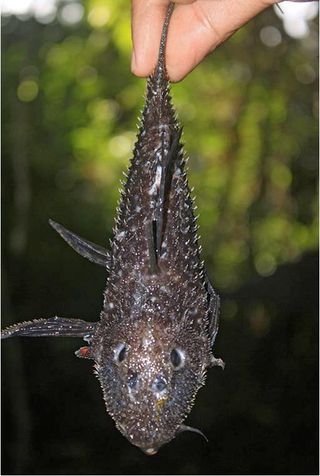
Conservation International (CI) announced, on Jan. 24, 2012, results from a three-week survey in southwest Suriname that documented nearly 1,300 species, including 46 species that may be new to science. Called the Rapid Assessment Program (RAP), the survey explored three remote sites along the Kutari and Sipaliwini Rivers near the village of Kwamalasumutu from August to September 2010, in an effort to document the region’s poorly known biodiversity and help develop sustainable ecotourism opportunities for the local people.
Shown here, a catfish species (Pseudacanthicus sp.) whose armor (external bony plates) is covered with spines. The armor likely protects the fish from the huge piranhas in the Sipaliwini River where it lives. The river it lives in is full of huge piranhas, so it must be well defended. One of the local guides was about to snack on this fish, until the experts preserved it as a scientific specimen. [Read full story]
Krazy Katydids
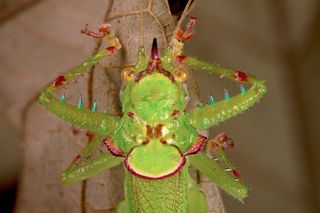
This spectacular conehead katydid (Loboscelis bacatus), previously known only from Amazonian Peru, was seen by scientists in southern Suriname, significantly extending its known range. Katydids are recognized by scientists as indicators of habitat disturbance for an ecosystem. They tend to stay within small specific habitats and do not disperse widely. They are highly sensitive to changes in their habitat, particularly fragmentation. They are also important herbivores and food source for birds, bats and primates.
Waterfall Beetle
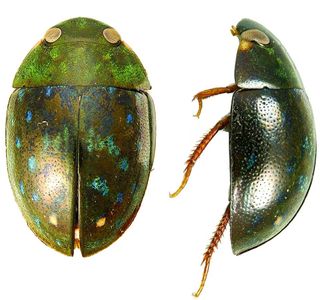
A potentially new water beetle species (Oocyclus sp.); called a waterfall beetle, the species is from Venezuela and is similar to a new species found on a granite inselberg (a type of mountain) in Suriname. This group of beetles only occurs in the waterfalls and wet rocks on mountains and rock outcrops. Most species are adorned with emerald and blue iridescence.
Cowboy Frog
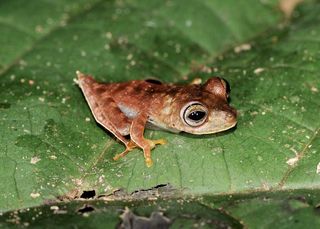
Nicknamed a cowboy frog, this possible new species (Hypsiboas sp.) sports white fringes along the legs and a spur on its heel. The frog was discovered low on a small branch during a night survey in a swampy area west of the RAP base camp at the Koetari River during Conservation International's Rapid Assessment Program in southwest Suriname in August and September 2010.
Amphibian Spurs
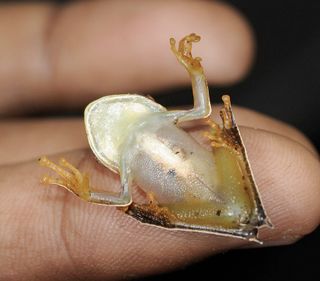
Another view of the cowboy frog, showing its white fringes and heel spurs.
Tortoise Beetles
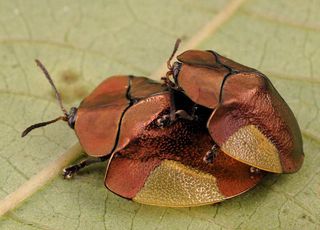
A mating pair of tortoise beetles (Cyrtonota lateralis), named after the broad dorsal surface that covers and protects them like a tortoise shell. Though not new to science, this species was observed during Conservation International's Rapid Assessment Program in southwest Suriname in August and September 2010.
Cute Beetle
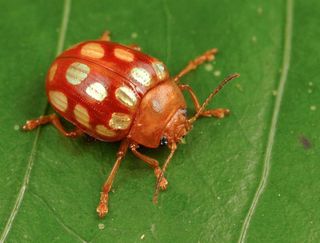
This leaf beetle (Stilodes sedecimmaculata) is found only in the Guyana Shield — a geological formation that underlies Guyana, Suriname and French Guiana, as well as parts of Colombia, Venezuela and Brazil. More than 35,000 leaf beetle species exist in the world, many feeding only on a particular type of host plant. The beetles store toxic chemicals from the plants they eat, and advertise this toxicity with bright colors to warn off predators. This species, though not new to science, was seen in southwest Suriname during a 2010 Conservation International survey.
Sign up for the Live Science daily newsletter now
Get the world’s most fascinating discoveries delivered straight to your inbox.
Daring Dung Beetle
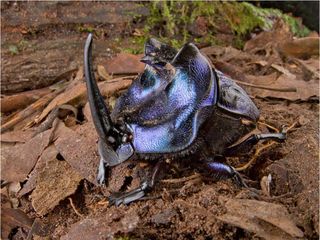
The largest dung beetle in the Neotropics, Coprophanaeus lancifer is not one to mess with. Females of the species are equipped with weaponry — a long head that they use to battle with other females over animal carcasses. Males also use a long horn to fight over females. With an enormous thorax filled almost entirely with muscle, C. lancifer is incredibly strong. In places where the species is common, it may bury an animal carcass as large as a pig in only a few days. This species, while not new to science, was observed by scientists working with Conservation International's Rapid Assessment Program in southwest Suriname in September 2010.
Pac-Man Frog
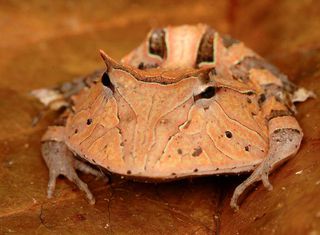
Observed in Suriname during a Conservation International survey (though not new to science), the Suriname horned frog or "Pac-Man frog" (Ceratophrys cornuta) is a voracious sit-and-wait predator. It has an exceptionally wide mouth, which allows it to swallow prey nearly as large as its own body, including mice and other frogs.
Damselfly Duo
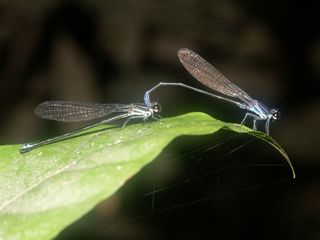
A male and female of a potentially new species of damselfly in the genus Argia, shown in tandem at Iwana Samu. Four of the eight species of this genus found during this RAP are new to science. The new species photographed here breeds in forest swamps, and its adults perch on rocks, logs and twigs close to the water’s surface, and on leaves, twigs and on the ground along forest trails near swamps, usually on bare substrates in the sun.
Crayola Katydid
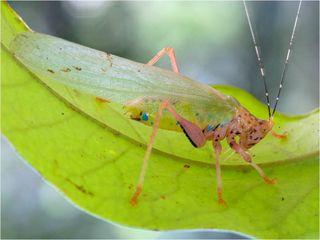
This potentially new species of katydid belongs to the genus Vestria, a group that includes four species known from lowland forests of Central and South America. These insects, nicknamed "Crayola" katydids due to their striking coloration, are the only katydids known to employ chemical defenses, which are effective at repelling bird and mammalian predators. This species was discovered by scientists working with Conservation International's Rapid Assessment Program in southwest Suriname in August and September 2010.












